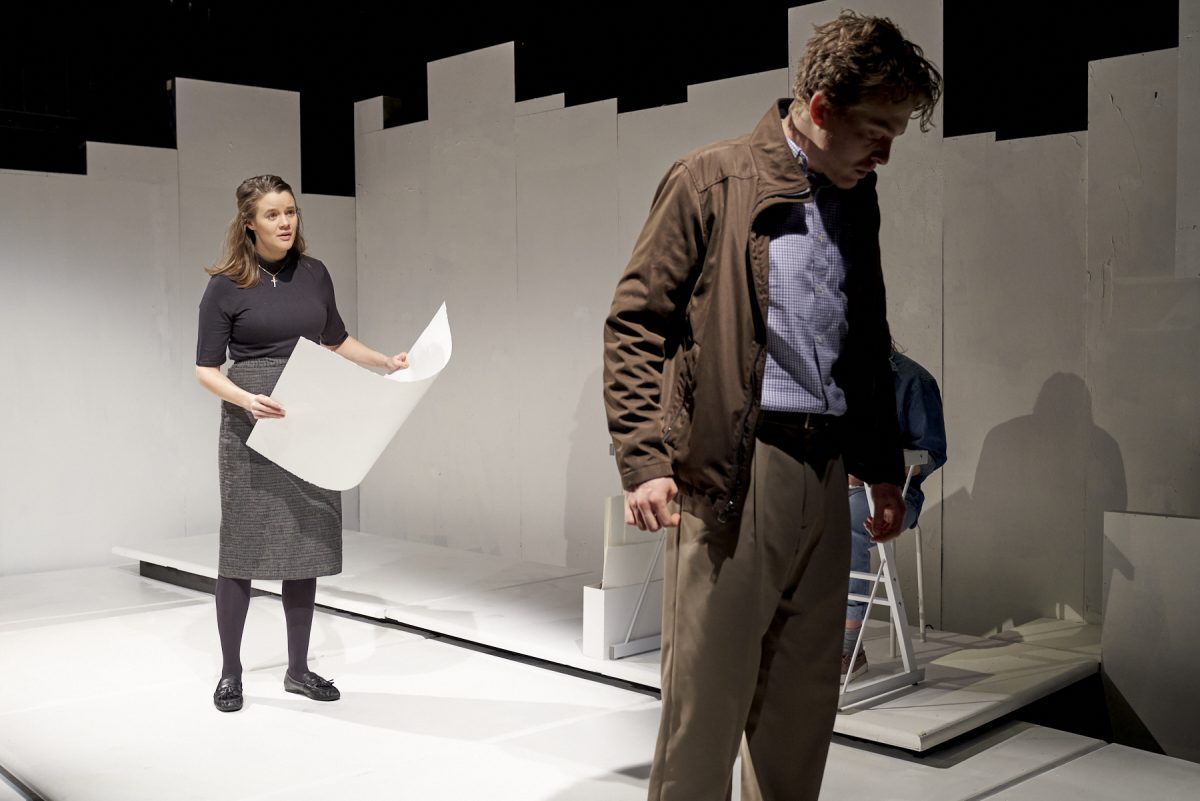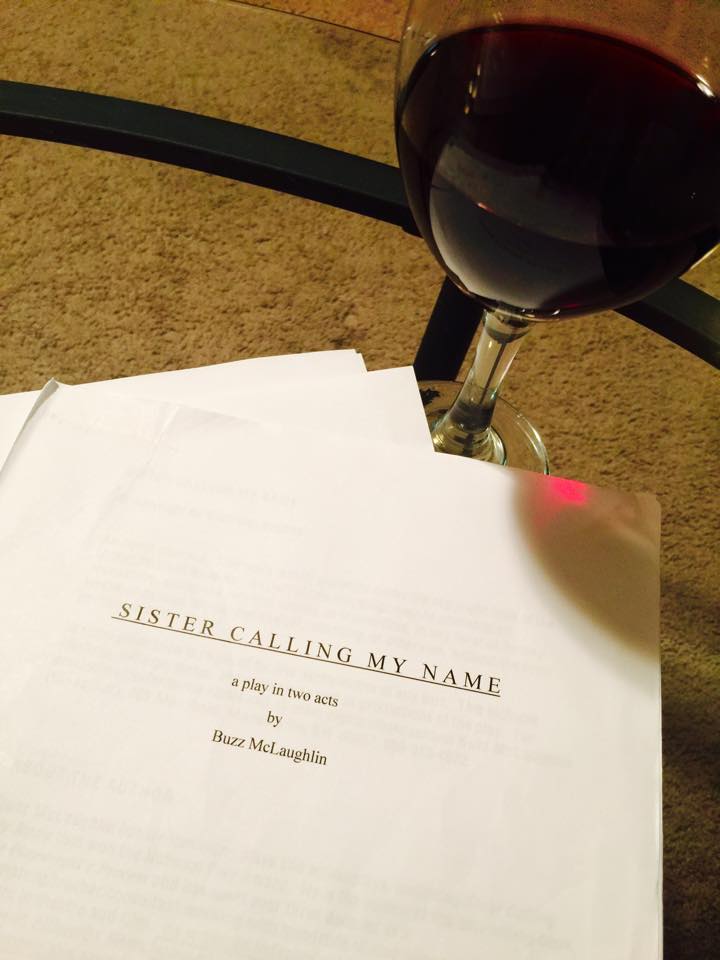
Buzz’s award-winning play “Sister Calling My Name” was performed January 24–February 16, 2020 at the Sheen Center, 18 Bleecker St., NYC–take a look at this review by Kathryn Jean Lopez in The National Review
Sister Calling My Name
Winner of the National Repertory Theatre’s 1996 National Play Award. Selected productions: Charlotte Repertory Theatre (LORT premiere), Bloomington (IN) Playwrights’ Project, Playwrights Theatre of New Jersey, Art Station (Atlanta), Pacific Theatre (Vancouver), Trilemma Productions (Orlando), Word Players (Knoxville), Regent University (VA), Open Window Theatre, Minneapolis, plus numerous others.
This is a memory play, highly theatrical in style, shifting between the present and the past, some scenes involving both simultaneously. It centers on Michael and his reluctant reunion with his developmentally disabled sister Lindsey, an artist of extraordinary skill who has started receiving serious attention from the mainstream art world. She also has a strong need to reestablish contact with her brother. Her guardian, mentor, and friend is a nun, Sister Anne, a woman of keen intelligence and spirit whom Michael was in love with years before. Through a complicated and empassioned encounter with SisterAnne, Michael ultimately comes to terms with Lindsey–a journey from total rejection to an embracing of her humanity and worth as a person. In the process he discovers a new sense of himself and his own spirituality. One man (35), two women (34, 36); simple unit set.
Absent Without Leave
Winner of Theatre Americana’s David Ellis Memorial Award, Los Angeles. Productions: Stone Table Theatre Company (Chicago); Theatre Americana (Los Angeles). Readings/workshops: Wheaton College Arena Festival (IL); Playwrights Theatre of New Jersey; Lamb’s Theatre ( NYC); New Harmony Project (IN).
The play centers on Matt Staley, 40, a television producer, and his struggle to come to terms with a long-term estrangement from his recently deceased father, a separation spawned by the father’s alcoholism. Set in the family home in a small southern Minnesota town as Matt and his three sisters gather to settle their father’s estate, the play focuses on Matt’s healing process, a journey from denial to forgiveness. Basically realistic in style, nonrealistic elements emerge as the father begins appearing within the actual and realistic world established. Three men (19, 40, 75); three women (35, 37, 45); one unit set.
Spirit on the Plains
(a trilogy of related one-act plays)
Winner of NJ State Arts Council Playwriting Fellowship Award and numerous one-act competitions including Attic Theatre Center’s One-Act Marathon (Los Angeles), National One-Act Playwriting Contest (IA), National One-Act Play Competition (VA), Regent University’s One-Act Play Festival (VA), Wheaton College’s Arena Festival (IL). Productions of trilogy: Bethel College (St. Paul); Drew University (NJ), Bates College (ME). Readings/workshops: New Harmony Project (IN), Lamb’s Theatre (NYC). Productions of individual one-acts: Wheaton College, Regent University, 12 Miles West Theatre (NJ), Dubuque Fine Arts Players (IA), Little Theatre of Alexandria (VA), Mill Mountain Theatre (VA), Attic Theatre (Los Angeles), Nantucket Theatre Co.
Set in farm country of southern Minnesota, Spirit on the Plains examines the life of young Aron Ward at the crossroads of three pivotal relationships –with a woman he meets at a dance hall (“Unexpected Delights”), with his best friend (“Buddy System”), and with his aging grandfather (“Fall Planting”). Each encounter reveals the potential for discovery, miracle, and compassion as Aron struggles to come to terms with his alcoholic father and his own emergence as a man. Three men (two in their late teens, one elderly), one woman (20); simple unit set. The individual plays are often produced independently.
Traverse des Sioux
Readings/workshops: The New Harmony Project, John Harms Center for the Arts (Englewood, NJ), Playwrights Theatre of New Jersey.
On a secluded bank of the Minnesota River, the ancient fording place of the Dakota Sioux, a man in crisis faces himself and makes his own crossing…
The time is a summer night in 1977; the place–a series of sandstone ledges rising above a wide, swift-flowing river. The steady, distant pulse of an Indian drum can be heard. As the lights come up, a distraught Neil Hamlin, 29, is discovered on his knees in a makeshift prayer circle on a lower ledge. Above him, on a higher outcropping, stands Tun-kan=i, a timeless Santee Dakota Indian warrior painted for battle, looking down on Neil. So begins a journey in which a man struggles with his rage at the disappointments life has dealt him, a journey that leads us into Neil=s mind and memory as he faces himself and his own selfish desires. While using externally the core spiritual belief of the American plains Indians that a man must die to self on a daily basis, the play is in reality a metaphyical presentation of Christian conversion as Neil experiences the death of the old self and rebirth as a new man. Shifting between scenes in 1977 (“the present”) and various scenes during the Viet Nam War years, a unit set is utilized consisting of a series of simple ledges rising above and behind the imagined river. Five actors–2 white males, late twenties; 1 white male, late teens; 1 white female, late twenties; 1 male American Indian, thirties. While recorded instrumental rock music, predominately drums and lead guitar, is heard in several scenes, Indian drumming is used extensively and ideally would be performed by a live drummer.
Leaving Jane
Finalist for the O’Neill National Playwrights Conference, PlayLabs, and the New Harmony Project; reading (with Marylouise Burke as Jane) in association with Penquin Rep (NYC).
For thirty-eight years Jane Murray, 69, has lived an independent, if somewhat eccentric life alone in a rent-controlled apartment on Jane Street in Greenwich Village. Now her building, a once grand, but now crumbling townhouse, has been sold to a man who’s begun a major renovation and who has managed, through pressure tactics and buyouts, to get his tenants to vacate. All except Jane, that is, who has no intention of leaving and has declared her own personal war against him, although this is taking a heavy toll on her physical and emotional health. Financially strapped and unemployed, she’s recently suffered a mild stroke and, as the renovation moves into high gear, has begun obsessing over her situation. Enter Jean, Jane’s younger sister by two years, making her weekly visit. Living an upscale life in the suburbs with her husband of thirty-six years, Jean is alarmed at the increasing deterioration of Jane’s mental state and realizes this may be her last chance to rescue her. Faced with Jane’s life-long ability to manipulate her, Jean struggles valiantly to convince Jane that it’s time to give up the fight. In the process a long-hidden and painful family secret surfaces and the sisters discover just how deep their love runs for each other, a love that ultimately releases Jane from her self-imposed entrapment. Throughout the play, which is basically comic in tone, both characters confide in the audience, sharing their fears and frustrations and giving their own spins on what’s transpiring. Two older women. Unit set consisting of Jane’s apartment, the hallway outside the apartment, the front entrance and steps, and the sidewalk in front of the building.
Transcendence
Workshopped at Lamb’s Players Theatre Writers Week (San Diego); read at Art Within Theatre Co. (Atlanta).
The play is a meeting between Marie Courbet, an embittered older woman who has lost a once vibrant faith, and Father Raphael, a devout Carthusian monk who is terminally ill. Nearly forty years before the two were deeply in love. Marie was instrumental in leading Father Raphael (then David Frankel, a young Jewish Navy veteran) to his faith and in the midst of their romance he experienced a calling to the priesthood and the monastic life. They haven’t seen each other since the day he left for his life of seclusion. In the intervening years, Marie has suffered through a difficult marriage, the tragic death of a child, and has slowly allowed her faith to evaporate. Father Raphael has spent his years enriching his spiritual life and struggling to grow in holiness. Now, with Marie learning of Father Raphael’s illness, the two arrange for this one final encounter. The play, framed by this meeting, travels freely back and forth through time, using two actors playing the older present characters and two actors playing the younger versions of the characters from the past. Throughout the focus is on Marie struggling to come to terms with her own bitterness and her discovery of the healing power of forgiveness. Two men (mid-twenties, late sixties), two women (early twenties, sixties); simple unit set.
From the New York City production of “Sister Calling My Name” (Blackfriars Repertory Theater & Storm Theatre)





From the Minneapolis production of “Sister Calling My Name” (Open Window Theatre)





